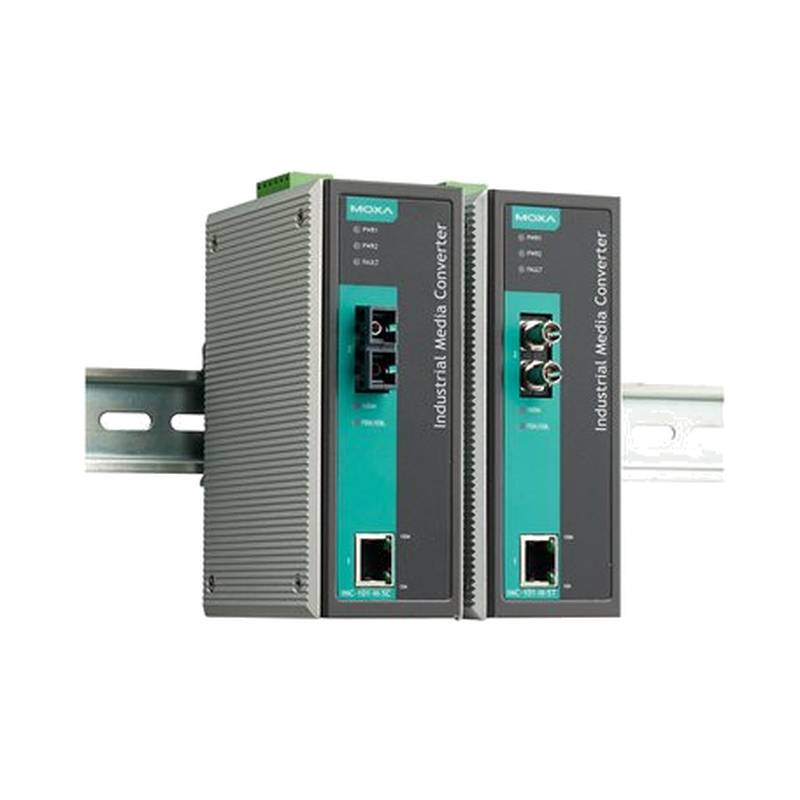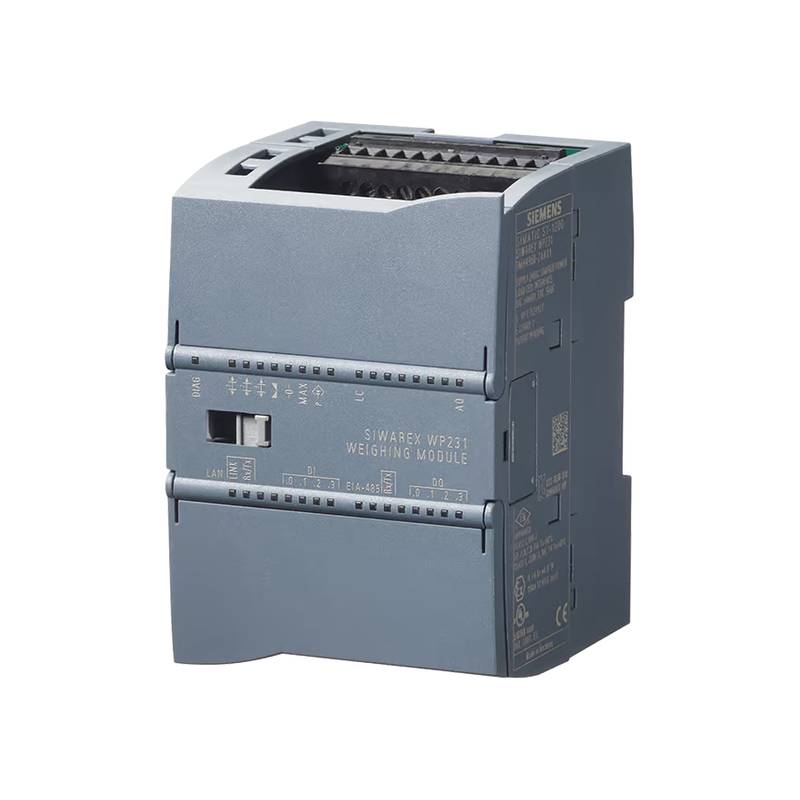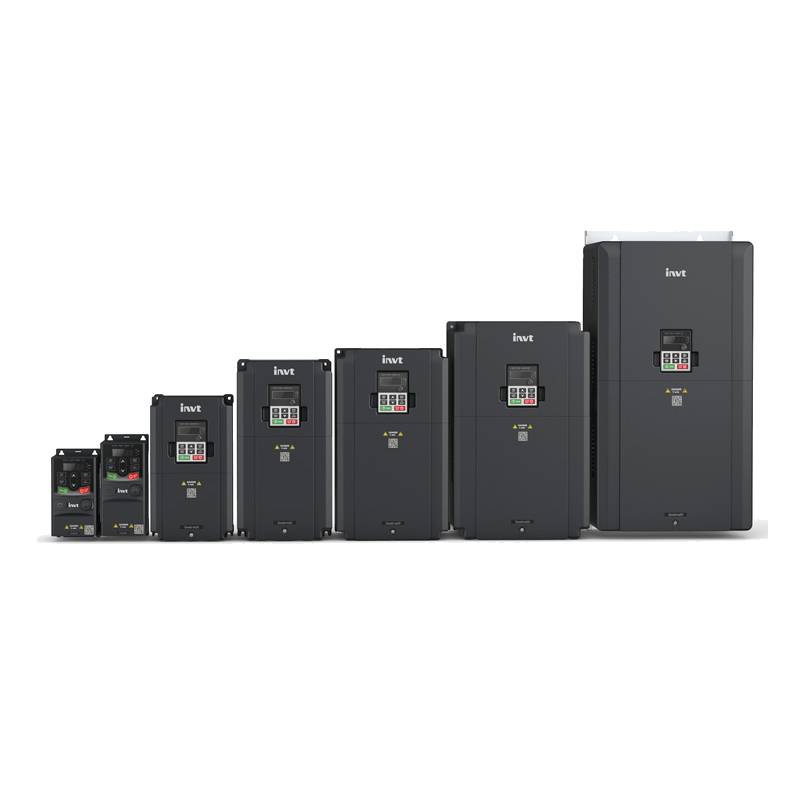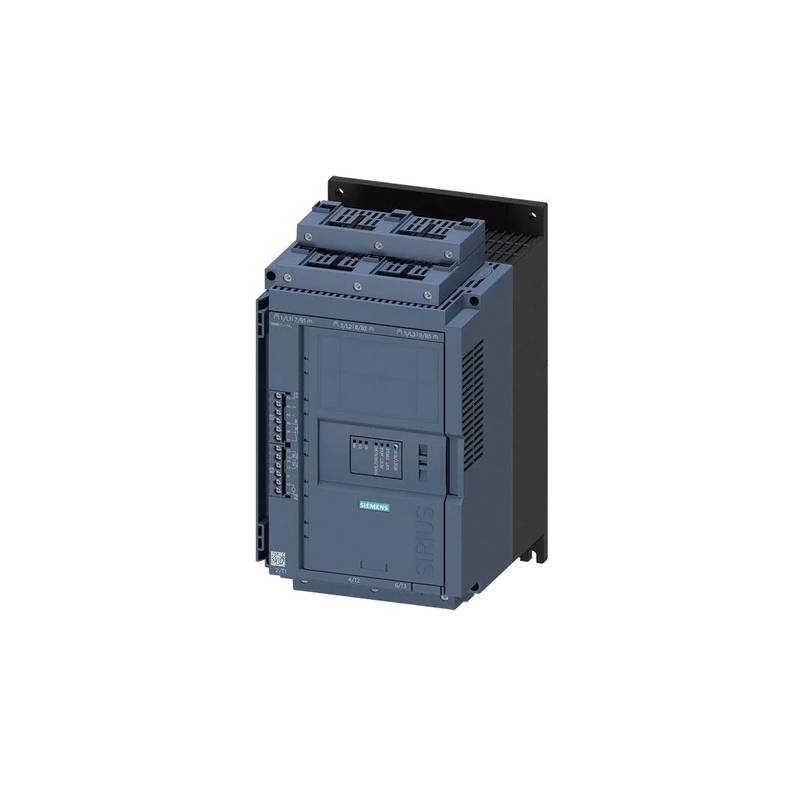
The Moxa IMC-101-M-ST-T is a robust 100M multi-mode fiber media converter, engineered to bridge the gap between different network media types in demanding industrial environments. This device excels in extending Ethernet networks over longer distances using multi-mode fiber optic cable, terminated with ST connectors, while incorporating Moxa's proprietary Turbo Ring technology for millisecond recovery time in ring topologies. Its operational temperature range of -40 to 75°C ensures reliable performance in harsh conditions, making it a critical component for industrial automation, transportation, and utility sectors.
Product Specifications
| Feature | Specification |
| :-------------------- | :---------------------------------------------- |
| Network Port | 1 x 10/100BaseTX RJ45 auto-MDI/MDIX |
| Fiber Port | 1 x 100BaseFX Multi-mode ST Connector |
| Fiber Wavelength | 1310 nm |
| Fiber Distance | Up to 2 km |
| Switching Fabric | 1 Gbps |
| Packet Buffer | 128 KBytes |
| Turbo Ring Recovery | < 10 ms (at 250 switches) |
| Input Voltage | 12/24/48 VDC (9.6 - 60 VDC) |
| Power Consumption | Max. 2.5 W |
| Operating Temperature | -40 to 75°C (-40 to 167°F) |
| Mounting | DIN-Rail, Wall mount, Panel mount |
| Dimensions | 31 x 95 x 75 mm (1.22 x 3.74 x 2.95 in) |
| Enclosure | IP30 |
| Certifications | CE, FCC, UL 508, ATEX |
Core Features & Market Positioning
The Moxa IMC-101-M-ST-T distinguishes itself through its integration of millisecond-level ring redundancy with Turbo Ring technology, a critical differentiator in industrial networks where downtime is unacceptable. This feature, combined with its wide operating temperature range, ensures consistent network uptime even under extreme environmental duress. The multi-mode ST fiber port offers an economical yet effective solution for extending network reach up to 2 kilometers, making it highly competitive for applications requiring moderate fiber connectivity. Its robust industrial design and comprehensive certifications further solidify its position as a reliable and compliant choice for critical infrastructure.
Key Application Scenarios
This media converter is ideally suited for industrial Ethernet networks that require reliable data transmission over moderate distances with fiber optic isolation. Common applications include connecting control systems in manufacturing plants, extending networks across substations in the power and utility sector, and deploying communication infrastructure in Intelligent Transportation Systems (ITS) for traffic management and monitoring. The ability to integrate seamlessly into industrial ring topologies via Turbo Ring makes it particularly valuable for scenarios demanding high network availability, such as factory automation lines or railway communication systems.
Practical System Integration Guidance
Integrating the Moxa IMC-101-M-ST-T into an existing industrial network is straightforward. For power, connect a compatible DC power source (9.6-60 VDC) to the terminal block, observing polarity. The RJ45 port connects to your copper Ethernet devices (e.g., switches, PCs, PLCs) using standard Cat5e or higher cabling. The multi-mode ST fiber port connects to other fiber-enabled devices or switches using appropriate multi-mode fiber optic patch cords. For Turbo Ring configuration, connect multiple IMC-101-M-ST-T units in a ring topology, using one port for input and the other for output to the next device in the ring. Initial configuration, if required for specific ring settings or diagnostics, can often be done via a console port or web interface, though many deployments operate plug-and-play.
Operation and Risk Mitigation
The IMC-101-M-ST-T operates as a transparent bridge, forwarding Ethernet frames between copper and fiber segments. Proper installation, including secure connections and adequate power supply, is paramount. Risk mitigation involves ensuring the fiber optic cables are clean and undamaged before connection to prevent light loss or physical damage to the ST connectors. For power supply, using a redundant power source connected to the dual power inputs can prevent disruptions. In case of a network fault, Turbo Ring automatically reroutes traffic, with recovery typically under 10ms. LED indicators on the unit provide real-time status of power, link, and activity for each port, aiding in quick diagnostics.
Scalability & Long-Term Value
The IMC-101-M-ST-T offers significant long-term value by facilitating the extension of existing Ethernet infrastructure into areas previously unreachable by copper cabling, or where electrical interference is a concern. Its compatibility with standard industrial communication protocols and its ability to integrate into ring topologies allow for easy network expansion. While this specific model focuses on 100 Mbps multi-mode fiber, Moxa's broader product portfolio supports upgrades to higher speeds or single-mode fiber if future network demands require it, ensuring a clear upgrade path. Its robust build quality and industrial certifications also contribute to a long operational lifespan, minimizing the total cost of ownership.
Frequently Asked Questions
What is the maximum distance for the Moxa IMC-101-M-ST-T over multi-mode fiber?
The IMC-101-M-ST-T supports multi-mode fiber optic connections with a maximum transmission distance of up to 2 kilometers. This distance is achieved using 1310nm wavelength transceivers built into the ST fiber port. This range is suitable for many industrial applications within a plant or campus environment.
This distance limitation makes it ideal for bridging separate buildings or network segments within a large facility. Ensure you use appropriate multi-mode fiber cabling, such as OM2 or OM3, for optimal performance over this range.
How does Moxa's Turbo Ring technology benefit network reliability?
Turbo Ring provides ultra-fast network redundancy with recovery times under 10 milliseconds when used with up to 250 switches. If a fiber link in the ring fails, traffic is automatically and seamlessly rerouted through an alternate path. This ensures minimal interruption to critical industrial operations, preventing costly downtime.
This millisecond-level failover is crucial for real-time control systems, SCADA, and other applications where network connectivity must be continuously maintained. The technology is proprietary to Moxa but interoperates within a standard Ethernet framework.
What are the power requirements and operating temperature range of the IMC-101-M-ST-T?
The IMC-101-M-ST-T is designed for industrial environments and accepts a wide DC input voltage range, typically from 12/24/48 VDC (9.6 to 60 VDC). It also features dual power inputs for redundancy, enhancing operational reliability. The device boasts an impressive operating temperature range of -40°C to 75°C (-40°F to 167°F).
This broad temperature tolerance means the media converter can be deployed in extremely cold or hot conditions, such as unheated enclosures or areas near heavy machinery. The wide voltage input range also allows flexibility in choosing a suitable power source within existing industrial power infrastructures.
Can the Moxa IMC-101-M-ST-T be used in hazardous locations?
The IMC-101-M-ST-T has ATEX certification, indicating its suitability for use in potentially explosive atmospheres, specifically Zone 2 locations. This certification is critical for deployment in industries like oil and gas, chemical processing, or mining where flammable gases or vapors may be present. Always ensure correct installation practices are followed as per ATEX guidelines.
This ATEX rating means the device has been tested to ensure it will not ignite its surroundings under normal operating conditions. It's important to verify the specific ATEX zone rating and any installation restrictions applicable to your environment.
What type of fiber optic cable is compatible with the ST connector on this converter?
The IMC-101-M-ST-T utilizes an ST connector for its 100BaseFX multi-mode fiber port. This means it is compatible with standard multi-mode fiber optic cables, typically identified as OM1, OM2, OM3, or OM4. These cables have a larger core diameter compared to single-mode fiber, making them easier to handle and terminate.
When connecting, ensure the fiber optic patch cord is clean and has ST connectors on both ends. The "M" in the product name often signifies multi-mode, and the ST connector is a common, robust bayonet-style connector widely used in industrial settings.
How do I configure Turbo Ring on the IMC-101-M-ST-T?
Turbo Ring typically requires minimal explicit configuration for basic ring setups. Devices are interconnected in a ring, and the technology automatically establishes redundant paths and monitors ring integrity. For advanced settings, such as ring manager selection or specific recovery parameters, access to the device's management interface (e.g., web browser or console port) might be necessary.
The primary setup involves physically connecting the devices in a closed loop using both the fiber and copper ports as needed to create the desired network topology. The devices then auto-negotiate their roles within the Turbo Ring.
What is the difference between 100BaseFX and 100BaseTX in the context of this converter?
100BaseTX refers to the Fast Ethernet standard for copper twisted-pair cabling, typically using RJ45 connectors. 100BaseFX refers to the Fast Ethernet standard for fiber optic cabling, allowing for longer distances and immunity to electromagnetic interference. The IMC-101-M-ST-T bridges these two media types.
This conversion is essential for extending Ethernet networks beyond the 100-meter limit of copper cabling or for connecting networks in electrically noisy environments. The "FX" indicates fiber optic transmission, and the "T" in 100BaseTX signifies twisted-pair copper.
Does the IMC-101-M-ST-T support PoE (Power over Ethernet)?
No, the Moxa IMC-101-M-ST-T does not natively support Power over Ethernet (PoE) output. It requires a separate DC power input to operate, as detailed in its specifications. While it can connect to PoE-enabled devices, it does not provide power over its Ethernet port to such devices.
When integrating this converter, ensure that any connected PoE-powered devices receive their power through their own dedicated PoE injectors or PoE-capable network switches. The IMC-101-M-ST-T focuses solely on media conversion and network redundancy.
What are the implications of the IP30 enclosure rating?
An IP30 enclosure rating signifies that the device is protected against solid objects greater than 12.5 mm (like a finger) but offers no protection against water ingress. This rating indicates that the IMC-101-M-ST-T is intended for installation in control cabinets or protected indoor environments where it will not be exposed to dust or moisture.
This means careful consideration must be given to the installation location to prevent damage from environmental factors. It is not designed for direct outdoor exposure or washdown applications without additional protective housing.
How can I troubleshoot a broken fiber link with the IMC-101-M-ST-T?
First, check the LED indicators on both ends of the fiber link for activity or link status. Ensure the multi-mode ST connectors are clean and securely seated. Use a fiber optic light source and power meter to test the integrity and signal strength of the fiber cable itself. Verify that both media converters are powered on and functioning correctly.
If the link remains down, try swapping patch cables or temporarily connecting the devices directly to rule out issues with intermediate fiber splices or connections. Review the device's status via its management interface, if available, for any specific error logs or diagnostic information.

























